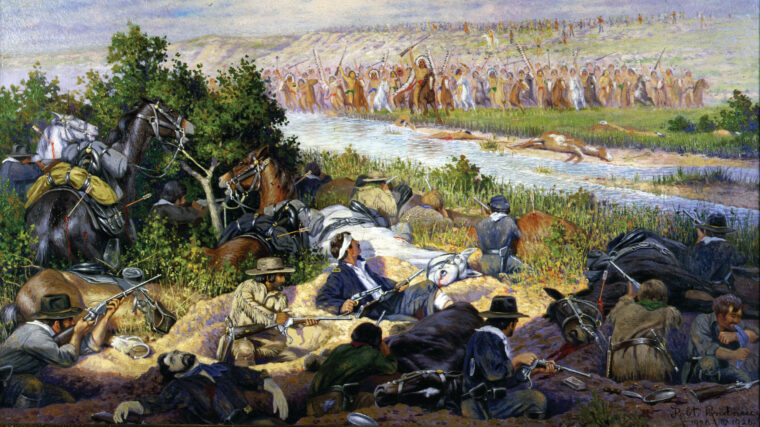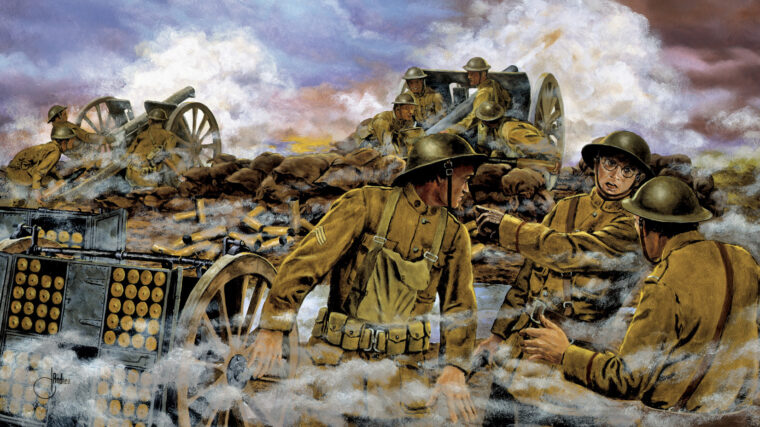
Military History
Medal of Honor Recipient: Henry Lawton
By Chuck LyonsOn August 3, 1864, near Atlanta, Georgia, Captain Henry Lawton of Indiana led a group of Union skirmishers in a charge against Confederate rifle pits. Read more


Military History
On August 3, 1864, near Atlanta, Georgia, Captain Henry Lawton of Indiana led a group of Union skirmishers in a charge against Confederate rifle pits. Read more

Military History
In the fall of 1447, Edmund Beaufort, Duke of Somerset, was not a happy man. He was lieutenant general of France and Guyenne, a kind of viceroy who oversaw English possessions in France, and he was also a powerful and rapacious feudal magnate in his own right. Read more

Military History
In ad 1205, Mongol ruler Genghis Khan, having completed the unification of his Gobi Desert empire, began looking south toward China for further conquest. Read more

Military History
Marshal Gouvion Saint-Cyr was in a tight spot, and he knew it. It was the morning of August 26, 1813, and Saint-Cyr and his French XIV Corps were defending Dresden, the capital of Saxony, from a large and menacing Allied army that outnumbered his own by at least four to one. Read more

Military History
The 3rd century BC in Greece was an age of military innovation. The lessons learned in the Peloponnesian War (431-404) led to the increased use of lightly armed troops and cavalry. Read more

Military History
As the first rays of sunlight chased away the shadows from the base of the high walls surrounding the village of Ravenna in northern Italy on Easter Sunday, April 11, 1512, the French army besieging the town began to form into columns. Read more

Military History
“Indians! Indians!” The staple warning from countless cliché-ridden dime novels was all too real at dawn of a Colorado morning in 1868. Read more

Military History
On January 18, ad 532, a 54-year-old eunuch by the name of Narses, described by Agathias, a contemporary chronicler, as “small in stature and of abnormal thinness,” entered alone into the Hippodrome of Constantinople carrying a bag of gold. Read more

Military History
On a sweltering evening in early July 1553, the late King Henry VIII’s only legitimate son, the sickly 15-year-old Edward VI, died an agonizing death from tuberculosis, possibly complicated by measles. Read more

Military History
On a sultry summer night in 9 BC, 29-year-old commander of Augustus Caesar ’s army in Germania bolted upright in his cot, dripping with sweat. Read more

Military History
Maharaja Ranjit Singh, ruler of the Sikh empire in northern India, was dead. Under his intrepid leadership, starting in 1799, Afghan control over Punjab, or Five Rivers Land, was thrown off and the Sikh empire flourished over the next 40 years. Read more

Military History
Just a few days after Britain and Germany declared war in August 1914, their territories in East Africa declared peace. Read more

Military History
The shafted ax has been around since 6000 bc, in both peaceful and warlike uses. The so-called battle-ax cultures (3200 to 1800 bc) extended over much of northern Europe from the late Stone Age through the early Bronze Age. Read more

Military History
Jan Zizka belongs to the elite group of leaders who never lost a battle. He was born on or around 1360 in the village of Trocnov in the Kingdom of Bohemia. Read more

Military History
In the darkness and driving rain on August 29, 1918, German artillery shells smashed down on American artillerymen fighting on a fir-clad slope in the Vosges Mountains in Alsace. Read more

Military History
For nearly 200 years, India was the jewel in the crown of the British Empire. Untold wealth flowed from such cities as Bombay, Madras, and Calcutta, supplying Great Britain with much of what made it possible to construct its world empire. Read more

Military History
Tired, battered, and bruised, the Spaniards had put up a brave fight, but the enemy had proven too powerful. Read more

Military History
Brimming with gale force winds, uncharted reefs, and a force of 21 enemy ships of the line, the bay seemed to be a deathtrap for the flagship Royal George. Read more

Military History
On December 12, 1466, a small group of horsemen led by an old man with a long white beard rode up to the gates of Rome. Read more

Military History
Few in the unincorporated community in Baltimore County that bears his name know of the deeds of the eminent American brevet Maj. Read more